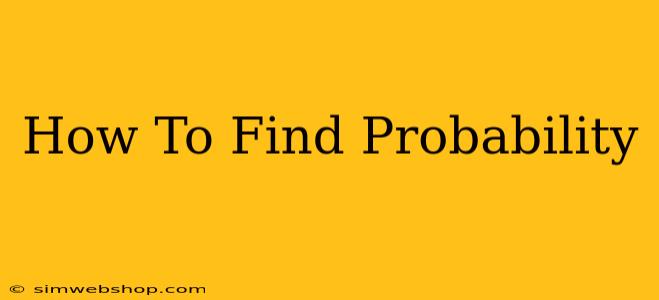Understanding probability is crucial in various fields, from statistics and data science to gambling and risk assessment. This guide provides a clear, step-by-step approach to calculating probability, covering both simple and more complex scenarios.
What is Probability?
Probability measures the likelihood of an event occurring. It's expressed as a number between 0 and 1, where:
- 0 indicates the event is impossible.
- 1 indicates the event is certain.
- Values between 0 and 1 represent the probability of the event occurring, with higher values indicating a greater likelihood.
Calculating Probability: Basic Concepts
The fundamental formula for probability is:
Probability (Event) = (Number of favorable outcomes) / (Total number of possible outcomes)
Let's break this down with an example:
Example: What's the probability of rolling a 3 on a six-sided die?
- Number of favorable outcomes: 1 (there's only one 3 on a standard die).
- Total number of possible outcomes: 6 (there are six sides on the die).
Therefore, the probability of rolling a 3 is 1/6.
Types of Probability
Several types of probability exist, each with its own method of calculation:
1. Theoretical Probability
This is the probability calculated based on logical reasoning and the characteristics of the event. It's often used when dealing with idealized scenarios, like the die example above.
2. Experimental Probability (Empirical Probability)
This type of probability is determined from actual observations or experiments. It's calculated as:
Experimental Probability = (Number of times the event occurred) / (Total number of trials)
For instance, if you flipped a coin 100 times and got heads 53 times, the experimental probability of getting heads is 53/100.
3. Subjective Probability
This type of probability reflects an individual's belief or judgment about the likelihood of an event. It's often used when there's limited or no data available.
Advanced Probability Concepts
As you delve deeper into probability, you'll encounter more complex scenarios requiring additional techniques:
1. Conditional Probability
This refers to the probability of an event occurring given that another event has already occurred. It's denoted as P(A|B), which reads as "the probability of A given B." The formula is:
P(A|B) = P(A and B) / P(B)
2. Independent Events
Two events are independent if the occurrence of one does not affect the probability of the other. For independent events A and B:
P(A and B) = P(A) * P(B)
3. Dependent Events
Dependent events are those where the outcome of one event influences the probability of the other.
4. Mutually Exclusive Events
Two events are mutually exclusive if they cannot both occur simultaneously. For example, you cannot roll a 3 and a 5 simultaneously on a single die.
Practical Applications of Probability
Probability has widespread applications, including:
- Risk assessment: Evaluating the likelihood of hazards or risks in various fields.
- Finance: Predicting market trends and managing investment portfolios.
- Healthcare: Determining the effectiveness of treatments and diagnosing diseases.
- Weather forecasting: Predicting weather patterns based on statistical data.
- Quality control: Ensuring the quality of manufactured products.
Conclusion
Mastering probability requires understanding its fundamental concepts and applying the appropriate formulas to different scenarios. By grasping these principles, you'll be equipped to analyze and interpret data effectively in numerous contexts. Remember to practice regularly to solidify your understanding and build your skills.

